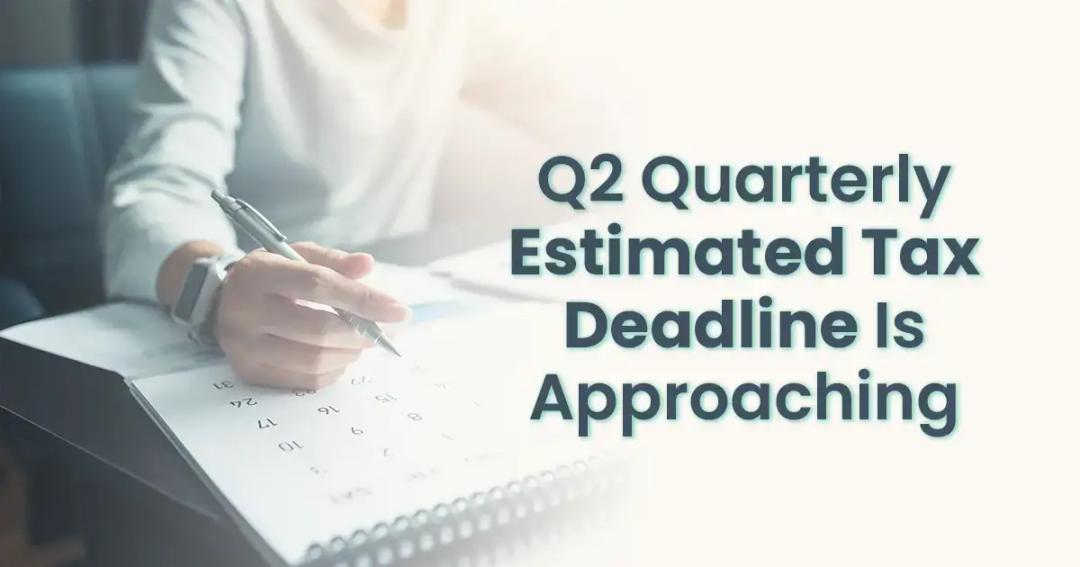
Summer is just around the corner, which means Q2 quarterly taxes are due for many small businesses. While some businesses use a service to calculate and submit what's owed, many owners will roll the dice and do it themselves, which makes them vulnerable to penalties and increased IRS scrutiny.
Use this blog as your guide if you'll handle your Q2 quarterly estimated taxes for your small business. You'll learn the ins and outs of calculating and submitting these taxes while familiarizing yourself with the pitfalls of missing a payment or miscalculating.
When is 2nd quarter estimated taxes due in 2023?
The second quarter refers to the period between April 1 to May 31, with the 2nd quarter estimated tax deadline in 2023 landing on June 15. You can pay your estimated taxes on income earned in the second quarter or a quarter of your estimated final income tax for the year.
When calculating your 2nd quarter taxes, it's best to be accurate. If you underpay throughout the year, you may face a late penalty from the IRS on next year’s tax return.
How to calculate your Q2 estimated taxes
The first step to calculating your Q2 estimated taxes is determining the income you're generating for the period. Easily reference your income via an IRS form 1040-ES. Use this form to input your expected income and deductions to calculate the final tax you expect to pay for 2023. Your quarterly tax will be one-fourth of your final tax. Corporations will use IRS form 1120-W to calculate their estimated taxes.
If your income hasn't changed significantly year over year, you can use this as the estimate on your tax form. Simply follow the same calculation and pay one-fourth of that amount every quarter.
Producing accurate estimations is stressful enough, and that's without potential penalties from the IRS. While the IRS can penalize small businesses that have underestimated quarterly income, it is less likely for first-time offenders.
How to pay your Q2 estimated taxes
Once your Q2 estimated taxes have been calculated, you should submit payment to the IRS by the Q2 tax deadline.
Where to file your Q2 taxes
There are several ways to pay what you owe to the IRS, including via post mail, phone, the IRS2Go app, and online.
Perhaps the easiest way to pay your Q2 estimated taxes is through the secure IRS platform known as the Electronic Federal Tax Payment System (EFTPS). After enrolling through the site, you can schedule and file your payments directly while keeping track of previous filings.
To enroll on the site or by phone, you must provide your social security or employer identification number. The IRS will then send you a secure PIN.
The IRS also accepts direct payments online without needing an account, but you’ll be responsible for recording the payments yourself.
Who needs to pay quarterly estimated taxes?
Small business owners, entrepreneurs, and many non-W-4 workers must typically pay quarterly estimated taxes.
According to the IRS, if individuals exceed a certain income threshold, they must pay estimated quarterly taxes, including:
- Corporations with total tax due that exceeds $500 when the return is filed.
- Individuals, which include sole proprietors, partners, and S corporation shareholders, who are expected to owe more than $1000 in taxes when the return is filed.
Only those without any tax liability during the previous full year will be exempt from paying estimated taxes.
Penalties for missing an estimated tax payment
Missing or miscalculating an estimated tax payment can invite penalties from the IRS. What you do in the wake of a potential penalty can impact the fine you might receive.
If you missed the Q2 tax due date, make the payment as soon as possible. If the IRS penalizes you, it will charge 0.5% of what you owe after the due date, with that percentage increasing as time goes on, capped at 25%. The IRS might waive the penalty if a late payment was due to an issue beyond your control.
If you don’t make sufficient quarterly tax payments throughout the year, then an extra penalty may be added to what you owe on your tax return. That amount will depend on how much you underpaid on your quarterly taxes. As with missing a payment deadline, the IRS might waive the penalty based on an exemption or other hardship.
Partner with Tax Professionals to Ensure Estimated Tax Compliance
Busy small business owners, entrepreneurs, and self-employed workers rarely have time to slow down and ask, When are second-quarter taxes due? Calculating and submitting quarterly estimated taxes multiple times per year can be overwhelming, which is why so many owners and entrepreneurs trust 1-800Accountant, America's leading virtual accounting firm for small businesses, for their QET needs.
Whether it's small business taxes, tax advisory, or any of our professional accounting services, we have the solution you need at a price that works for you. Schedule a quick consultation – usually 30 minutes or less – to learn how we can help.
This post is to be used for informational purposes only and does not constitute legal, business, or tax advice. Each person should consult his or her own attorney, business advisor, or tax advisor with respect to matters referenced in this post. 1-800Accountant assumes no liability for actions taken in reliance upon the information contained herein.
